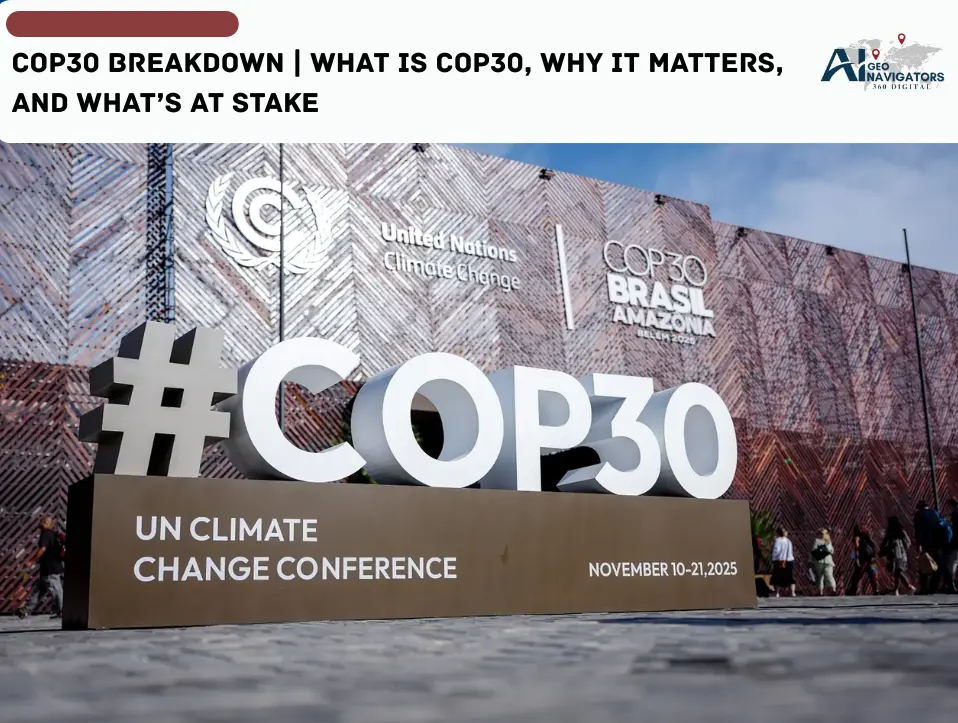Imagine standing on the coastline of a small island nation as the sun rises. The ocean, once calm and predictable, is now inching closer to homes every single year.
Fishermen notice fewer fish. Farmers feel the heat intensifying. Cities experience floods that used to be “once in a lifetime” now happening every few years.
This is not science fiction. This is our world today.
Amid this rapidly shifting climate reality, humanity gathers once a year to decide how to shape the planet’s future. That gathering is called the United Nations Climate Change Conference, better known as the COP Conference of the Parties.
And the year 2025 brings a pivotal milestone: COP30, hosted in Belém, Brazil, a historic location at the gateway of the Amazon rainforest.
Why is this summit so important?
Why are world leaders, scientists, activists, and industries calling it “the most decisive COP yet”?
Why does it matter not only for governments but for families, children, businesses, and entire generations?
Let’s dive deep into the meaning, purpose, and impact of COP30, and why the world is watching so closely.
What is COP30?
COP30 is the 30th annual United Nations Climate Change Conference, happening in 2025. It is part of the global process under the UNFCCC (United Nations Framework Convention on Climate Change), where nearly 200 countries come together to negotiate climate actions.
Primary Goal of COP30
To accelerate global efforts to limit global warming to 1.5°C, strengthen climate finance, cut greenhouse gas emissions, and support climate-vulnerable countries.
Why COP Matters
COP conferences are where major agreements like the Kyoto Protocol, the Paris Agreement, and Global Stocktake measures have been born.
COP30 is expected to be especially important because it marks:
- The 10-year midpoint of the Paris Agreement
- A global emissions deadline scientists say we must cut emissions 43% by 2030
- A period of rising climate disasters, from floods to wildfires
- A moment where governments must revise and upgrade their NDCs (Nationally Determined Contributions)
My Personal Quote: COP30 is where countries decide how aggressively they will fight climate change for the next decade.
Where and When Will COP30 Take Place?
Location: Belém, Brazil
Belém sits at the mouth of the Amazon River and serves as a gateway to the world’s most important ecosystem, the Amazon Rainforest.
Mon, Nov 10, 2025 – Fri, Nov 21, 2025
Why Belém is Symbolic
- It is in the heart of the Amazon, home to 10% of Earth’s biodiversity.
- The region faces severe threats from deforestation, illegal mining, and extreme droughts.
- Indigenous communities key protectors of the forest live here.
Hosting COP30 in Belém sends a global message:
Protecting forests is central to saving the climate.
Why COP30 Matters More Than Previous Conferences
COP30 is not “just another meeting.” It is a turning point.
Here’s why:
1. The 1.5°C Limit Is at Risk
The world is already around 1.1–1.2°C warmer than pre-industrial levels.
Scientists warn that the remaining carbon budget to stay under 1.5°C is rapidly shrinking.
If emissions continue rising:
- Deadly heatwaves will multiply
- Coastal cities will face irreversible flooding
- Food production will decline
- Climate-driven migration will accelerate
COP30 may be the final chance for coordinated global action to stay below 1.5°C.
2. Countries Must Submit Updated Climate Plans (NDCs 3.0)
Under the Paris Agreement, every 5 years countries must upgrade their commitments.
2025 is the next major deadline.
These updated plans (NDCs 3.0) will define:
- Emissions cuts for 2030 and 2035
- Renewable energy targets
- Deforestation strategies
- Adaptation measures
- Climate finance commitments
Negotiations at COP30 will shape the world’s climate path up to 2040 and beyond.
3. The World Is Facing Unprecedented Climate Events
Recent years have seen:
- Record-breaking temperatures
- Deadly floods in Pakistan, India, Europe, and Libya
- Wildfires in Canada, Greece, Australia, and the Amazon
- Droughts crippling agriculture worldwide
The urgency is stronger than ever.
4. Climate Finance Must Be Reformed
Developing countries need billions to:
- Adapt to rising temperatures
- Build resilient infrastructure
- Shift to renewable energy
- Recover from losses and damage
But current climate finance systems are slow, unclear, and insufficient.
COP30 aims to:
- Establish the New Collective Quantified Goal (NCQG)
- Increase funding for the Loss and Damage Fund
- Hold richer countries accountable for unmet promises
What Will Be Negotiated at COP30?
Here are the key negotiation areas:
1. Stronger Emission Reduction Targets
Countries will be pushed to:
- End coal expansion
- Increase renewable energy
- Electrify transport
- Cut methane emissions
- Implement carbon markets
2. Forest Protection (Especially the Amazon)
Given the location, forest and biodiversity protection will be a major focus.
Expect discussions around:
- Zero deforestation targets
- Payment-for-conservation models like REDD+
- Indigenous land rights
- Global biodiversity funding
3. Climate Finance and Loss & Damage
Developing countries will demand:
- More predictable climate finance
- Faster disbursement
- Debt relief for climate-stressed economies
- Support for climate disasters already happening
4. Adaptation and Resilience
Flood-prone, drought-prone, heat-stressed countries will highlight:
- Early warning systems
- Climate-smart agriculture
- Water resource management
- Infrastructure resilience
5. Fossil Fuel Phase-Out Roadmap
After COP28’s call to “transition away” from fossil fuels, COP30 may push for:
- A clear timeline
- Restrictions on new fossil fuel projects
- Just transition strategies for energy workers
Role of the Amazon and Brazil Climate Leadership
Brazil plays a major climate role due to:
- Its huge renewable energy potential
- Its leadership in protecting the Amazon
- Its influence over other forest nations
The Amazon absorbs massive amounts of carbon but deforestation is turning parts of it into a carbon emitter.
COP30 in Belém will highlight:
- Forest restoration
- Indigenous stewardship
- Loss of biodiversity
- Global responsibility for tropical forests
How COP30 Can Impact Climate-Vulnerable Regions
(Pakistan, India, Bangladesh, Philippines, African nations, and small island states)
These regions face:
- Deadly floods
- Heatwaves reaching 50°C
- Glacial melt and water scarcity
- Crop failures
- Cyclones and storm surges
COP30 outcomes can help by:
- Increasing funds for adaptation
- Improving flood warning systems
- Supporting climate-resilient agriculture
- Providing finance for rebuilding after disasters
- Pressuring major emitters to cut emissions faster
What Success at COP30 Could Look Like
A successful COP30 may deliver:
✔ Stronger, science-aligned NDCs
✔ A funded and operational Loss and Damage mechanism
✔ A global deforestation agreement
✔ A unified fossil fuel phase-out timeline
✔ Increased adaptation funding for vulnerable countries
✔ A roadmap for the mid-2030s emissions peak
✔ Inclusion of indigenous voices in climate governance
Challenges COP30 Must Overcome
COP30 faces several challenges:
- Political tensions
- Different countries have conflicting economic interests.
- Fossil fuel lobbying
- Oil, gas, and coal industries often influence negotiations.
- Insufficient finance
- Wealthy nations have not fully met their $100B/year pledge.
- Slow policy implementation
- Climate fatigue
- COP30 must rebuild global trust through action, not just promises.
How You Can Engage With COP30
(Citizens, youth, students, businesses, NGOs)
You can:
- Follow climate news and updates
- Join online climate campaigns
- Advocate for renewable energy adoption
- Reduce your personal carbon footprint
- Participate in local environmental groups
- Support climate-friendly businesses
- Contribute to reforestation and conservation initiatives
For businesses
- Adopt ESG strategies
- Shift to solar or hybrid energy
- Measure and reduce carbon emissions
- Support green innovations
For students and youth
- Join climate clubs
- Study sustainability fields
- Participate in climate research
- Engage on social media with evidence-based content
Frequently Asked Questions
What does COP30 stand for?
COP30 stands for 30th Conference of the Parties under the UNFCCC.
Why is COP30 important?
Because it will set new, stronger climate commitments for 2030 and 2035—key years for avoiding climate catastrophe.
What is the goal of COP30?
To strengthen global climate action, increase finance, protect forests, and push countries toward a 1.5°C pathway.
Will COP30 focus on forest protection?
Yes, especially the Amazon rainforest, biodiversity, and indigenous land rights.
How does COP30 affect developing countries?
It can bring more funding, adaptation tools, and support for climate disasters.
What are NDCs?
Nationally Determined Contributions countries’ official climate action plans.
What is the Loss and Damage Fund?
A fund established to help countries recover from climate-related destruction.
How can ordinary people contribute to COP30 goals?
By adopting sustainable lifestyles, supporting climate-friendly businesses, and advocating for clean energy. Conclusion: A Turning Point for Our Shared Future
COP30 is not just a conference. It is a moment of truth.
A test of global unity.
A chance to protect the Amazon, the planet’s climate, and billions of lives.
A moment when nations must choose courage over convenience.
The decisions made in Belém will shape our climate future for decades.
The question is:
Will the world act boldly? Or will we look back in regret?
The power is in our hands.
Our choices, our voices, and our actions big or small can tip the scale toward a safer, greener, and more hopeful world.


No responses yet